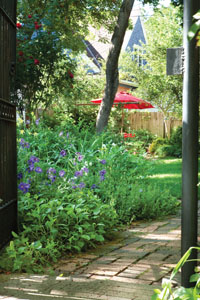Paying Homage to Trees
29 Jan 2011
Ravaged by disease or old age, a beloved tree can live on in a different incarnation.
If your favorite tree’s time is up, here are ideas to keep it around a little longer.
By Lisa Truesdale It’s easy to fall in love with a tree. Trees are symbols of permanence and faithfulness, reaching optimistically for the sky, standing strong and sturdy, year after year, no matter the weather or sea- son. Providing shade in the summer, protection from the wind, and vital oxygen. Asking little of us in return except for some routine care and a drink of water if it gets too dry.
- This sculpture by Chad Haspels is a memorial to a fallen firefighter, Allan Wyatt of Oregon, who lost his life fighting the Missionary Ridge Fire in Vallecito Lake, Colo. The sculptor carved it from a tree that was burned and broken in the fire.

- Stumped by a stump? Take inspiration from these homeowners who turned their stumps into birdhouse perches and a Zen water feature.

- Stumped by a stump? Take inspiration from these homeowners who turned their stumps into birdhouse perches and a Zen water feature.

- Sculptor Chad Haspels created a life-sized red-tailed hawk from a ponderosa pine. “Whenever I sculpt a tree, I try to take into account the local environment,” Haspels says. “In this case, the tree was in an area that had a large number of red-tailed hawks continually soaring above.”
Ultimate Recycling
Everything changes, and nothing lasts. That’s the Buddhist philosophy that Stacey Arnett and her husband Phil Penningroth live by, and it’s what guided them in their decision about what to do with a sick cottonwood tree in their Longmont yard. “It was sad, but it had to be taken down,” Arnett says. “We wanted to create something beautiful from what remained.” So they called Lueb Popoff, a local tree sculptor, who hollowed out the stump and sealed it. Then, their landscapers made it into a Japanese-inspired water feature. A bamboo pole carries the water into the cottonwood bowl and back out again to the black-stone-rimmed pond below, filled with lily pads. The sound of the falling water provides a calm, peaceful setting for the clients Arnett sees in her home office, which opens directly onto the garden. “Having this beautiful creation also reminds us of the reality that nothing lasts,” Arnett adds. “We’ve enjoyed it for several years, and as it begins to decompose, we need to treat it with coats of epoxy to help it last another season. “I guess it’s the process of ultimate recycling—back to the earth.”Inspired Artistry
A breathtaking, detailed work of art can magically emerge from an unsightly tree stump, thanks to the talents of a tree sculptor who is skilled with both a chain saw and smaller, more precise tools. There are several public creations in the area, like Haspels’ buffalo in Longmont, or the sculptures by artist Eddie Running Wolf in downtown Niwot that were commissioned by the town to reflect the area’s Native American history.
- Haspels’ carving of cougars and bears (left) is in a Pagosa Springs park. It was sculpted from an old-growth tree killed by multiple lighting strikes. The bench was carved from the tree’s upper portion.













